Arman Cohan
MRMR: A Realistic and Expert-Level Multidisciplinary Benchmark for Reasoning-Intensive Multimodal Retrieval
Oct 10, 2025Abstract:We introduce MRMR, the first expert-level multidisciplinary multimodal retrieval benchmark requiring intensive reasoning. MRMR contains 1,502 queries spanning 23 domains, with positive documents carefully verified by human experts. Compared to prior benchmarks, MRMR introduces three key advancements. First, it challenges retrieval systems across diverse areas of expertise, enabling fine-grained model comparison across domains. Second, queries are reasoning-intensive, with images requiring deeper interpretation such as diagnosing microscopic slides. We further introduce Contradiction Retrieval, a novel task requiring models to identify conflicting concepts. Finally, queries and documents are constructed as image-text interleaved sequences. Unlike earlier benchmarks restricted to single images or unimodal documents, MRMR offers a realistic setting with multi-image queries and mixed-modality corpus documents. We conduct an extensive evaluation of 4 categories of multimodal retrieval systems and 14 frontier models on MRMR. The text embedding model Qwen3-Embedding with LLM-generated image captions achieves the highest performance, highlighting substantial room for improving multimodal retrieval models. Although latest multimodal models such as Ops-MM-Embedding perform competitively on expert-domain queries, they fall short on reasoning-intensive tasks. We believe that MRMR paves the way for advancing multimodal retrieval in more realistic and challenging scenarios.
MSRS: Evaluating Multi-Source Retrieval-Augmented Generation
Aug 28, 2025Abstract:Retrieval-augmented systems are typically evaluated in settings where information required to answer the query can be found within a single source or the answer is short-form or factoid-based. However, many real-world applications demand the ability to integrate and summarize information scattered across multiple sources, where no single source is sufficient to respond to the user's question. In such settings, the retrieval component of a RAG pipeline must recognize a variety of relevance signals, and the generation component must connect and synthesize information across multiple sources. We present a scalable framework for constructing evaluation benchmarks that challenge RAG systems to integrate information across distinct sources and generate long-form responses. Using our framework, we build two new benchmarks on Multi-Source Retrieval and Synthesis: MSRS-Story and MSRS-Meet, representing narrative synthesis and summarization tasks, respectively, that require retrieval from large collections. Our extensive experiments with various RAG pipelines -- including sparse and dense retrievers combined with frontier LLMs -- reveal that generation quality is highly dependent on retrieval effectiveness, which varies greatly by task. While multi-source synthesis proves challenging even in an oracle retrieval setting, we find that reasoning models significantly outperform standard LLMs at this distinct step.
Demystifying Scientific Problem-Solving in LLMs by Probing Knowledge and Reasoning
Aug 26, 2025Abstract:Scientific problem solving poses unique challenges for LLMs, requiring both deep domain knowledge and the ability to apply such knowledge through complex reasoning. While automated scientific reasoners hold great promise for assisting human scientists, there is currently no widely adopted holistic benchmark for evaluating scientific reasoning, and few approaches systematically disentangle the distinct roles of knowledge and reasoning in these tasks. To address these gaps, we introduce SciReas, a diverse suite of existing benchmarks for scientific reasoning tasks, and SciReas-Pro, a selective subset that requires more complex reasoning. Our holistic evaluation surfaces insights about scientific reasoning performance that remain hidden when relying on individual benchmarks alone. We then propose KRUX, a probing framework for studying the distinct roles of reasoning and knowledge in scientific tasks. Combining the two, we conduct an in-depth analysis that yields several key findings: (1) Retrieving task-relevant knowledge from model parameters is a critical bottleneck for LLMs in scientific reasoning; (2) Reasoning models consistently benefit from external knowledge added in-context on top of the reasoning enhancement; (3) Enhancing verbalized reasoning improves LLMs' ability to surface task-relevant knowledge. Finally, we conduct a lightweight analysis, comparing our science-focused data composition with concurrent efforts on long CoT SFT, and release SciLit01, a strong 8B baseline for scientific reasoning.
AbGen: Evaluating Large Language Models in Ablation Study Design and Evaluation for Scientific Research
Jul 17, 2025Abstract:We introduce AbGen, the first benchmark designed to evaluate the capabilities of LLMs in designing ablation studies for scientific research. AbGen consists of 1,500 expert-annotated examples derived from 807 NLP papers. In this benchmark, LLMs are tasked with generating detailed ablation study designs for a specified module or process based on the given research context. Our evaluation of leading LLMs, such as DeepSeek-R1-0528 and o4-mini, highlights a significant performance gap between these models and human experts in terms of the importance, faithfulness, and soundness of the ablation study designs. Moreover, we demonstrate that current automated evaluation methods are not reliable for our task, as they show a significant discrepancy when compared to human assessment. To better investigate this, we develop AbGen-Eval, a meta-evaluation benchmark designed to assess the reliability of commonly used automated evaluation systems in measuring LLM performance on our task. We investigate various LLM-as-Judge systems on AbGen-Eval, providing insights for future research on developing more effective and reliable LLM-based evaluation systems for complex scientific tasks.
Can LLMs Identify Critical Limitations within Scientific Research? A Systematic Evaluation on AI Research Papers
Jul 03, 2025Abstract:Peer review is fundamental to scientific research, but the growing volume of publications has intensified the challenges of this expertise-intensive process. While LLMs show promise in various scientific tasks, their potential to assist with peer review, particularly in identifying paper limitations, remains understudied. We first present a comprehensive taxonomy of limitation types in scientific research, with a focus on AI. Guided by this taxonomy, for studying limitations, we present LimitGen, the first comprehensive benchmark for evaluating LLMs' capability to support early-stage feedback and complement human peer review. Our benchmark consists of two subsets: LimitGen-Syn, a synthetic dataset carefully created through controlled perturbations of high-quality papers, and LimitGen-Human, a collection of real human-written limitations. To improve the ability of LLM systems to identify limitations, we augment them with literature retrieval, which is essential for grounding identifying limitations in prior scientific findings. Our approach enhances the capabilities of LLM systems to generate limitations in research papers, enabling them to provide more concrete and constructive feedback.
SciArena: An Open Evaluation Platform for Foundation Models in Scientific Literature Tasks
Jul 01, 2025
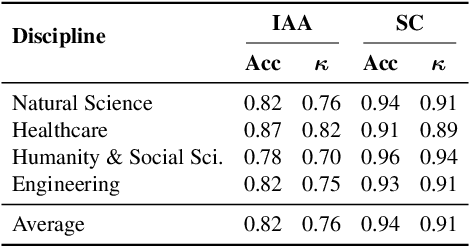

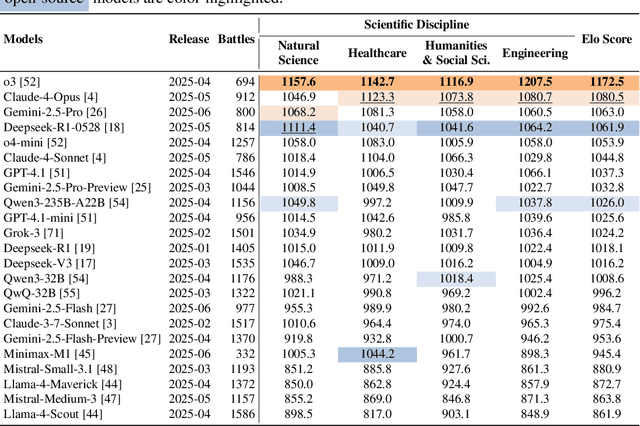
Abstract:We present SciArena, an open and collaborative platform for evaluating foundation models on scientific literature tasks. Unlike traditional benchmarks for scientific literature understanding and synthesis, SciArena engages the research community directly, following the Chatbot Arena evaluation approach of community voting on model comparisons. By leveraging collective intelligence, SciArena offers a community-driven evaluation of model performance on open-ended scientific tasks that demand literature-grounded, long-form responses. The platform currently supports 23 open-source and proprietary foundation models and has collected over 13,000 votes from trusted researchers across diverse scientific domains. We analyze the data collected so far and confirm that the submitted questions are diverse, aligned with real-world literature needs, and that participating researchers demonstrate strong self-consistency and inter-annotator agreement in their evaluations. We discuss the results and insights based on the model ranking leaderboard. To further promote research in building model-based automated evaluation systems for literature tasks, we release SciArena-Eval, a meta-evaluation benchmark based on our collected preference data. The benchmark measures the accuracy of models in judging answer quality by comparing their pairwise assessments with human votes. Our experiments highlight the benchmark's challenges and emphasize the need for more reliable automated evaluation methods.
SciVer: Evaluating Foundation Models for Multimodal Scientific Claim Verification
Jun 18, 2025Abstract:We introduce SciVer, the first benchmark specifically designed to evaluate the ability of foundation models to verify claims within a multimodal scientific context. SciVer consists of 3,000 expert-annotated examples over 1,113 scientific papers, covering four subsets, each representing a common reasoning type in multimodal scientific claim verification. To enable fine-grained evaluation, each example includes expert-annotated supporting evidence. We assess the performance of 21 state-of-the-art multimodal foundation models, including o4-mini, Gemini-2.5-Flash, Llama-3.2-Vision, and Qwen2.5-VL. Our experiment reveals a substantial performance gap between these models and human experts on SciVer. Through an in-depth analysis of retrieval-augmented generation (RAG), and human-conducted error evaluations, we identify critical limitations in current open-source models, offering key insights to advance models' comprehension and reasoning in multimodal scientific literature tasks.
SUCEA: Reasoning-Intensive Retrieval for Adversarial Fact-checking through Claim Decomposition and Editing
Jun 05, 2025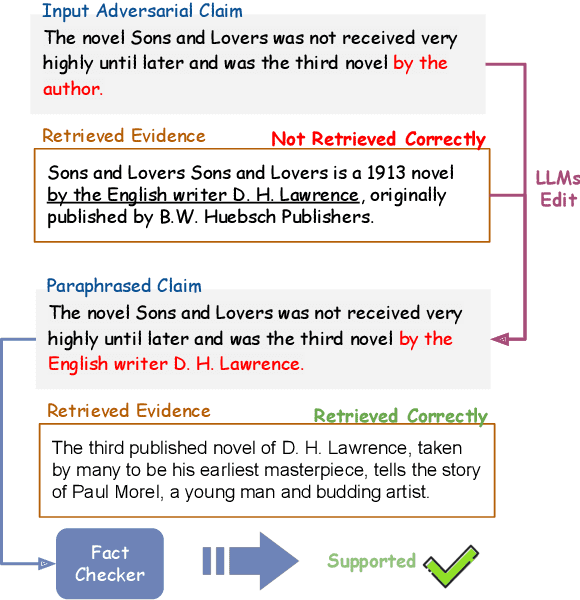
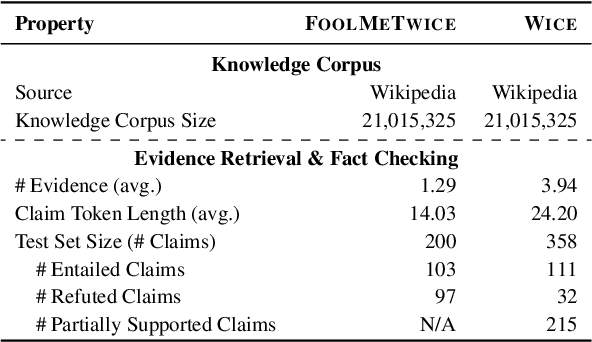
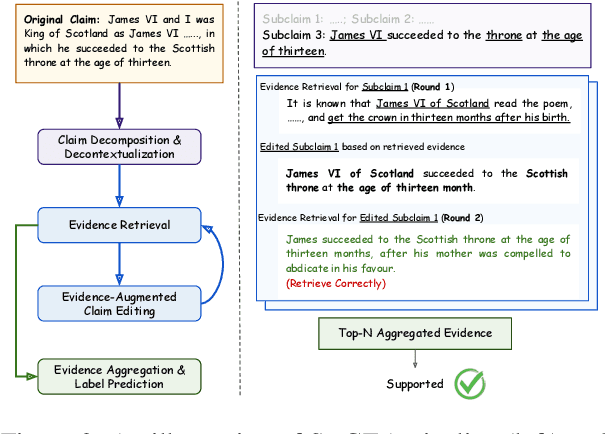
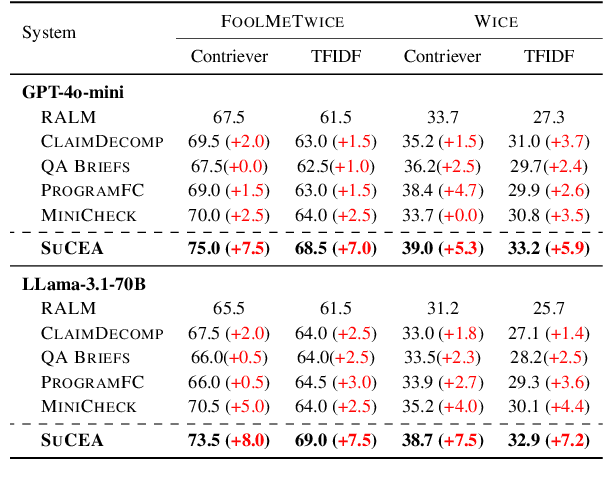
Abstract:Automatic fact-checking has recently received more attention as a means of combating misinformation. Despite significant advancements, fact-checking systems based on retrieval-augmented language models still struggle to tackle adversarial claims, which are intentionally designed by humans to challenge fact-checking systems. To address these challenges, we propose a training-free method designed to rephrase the original claim, making it easier to locate supporting evidence. Our modular framework, SUCEA, decomposes the task into three steps: 1) Claim Segmentation and Decontextualization that segments adversarial claims into independent sub-claims; 2) Iterative Evidence Retrieval and Claim Editing that iteratively retrieves evidence and edits the subclaim based on the retrieved evidence; 3) Evidence Aggregation and Label Prediction that aggregates all retrieved evidence and predicts the entailment label. Experiments on two challenging fact-checking datasets demonstrate that our framework significantly improves on both retrieval and entailment label accuracy, outperforming four strong claim-decomposition-based baselines.
MetaFaith: Faithful Natural Language Uncertainty Expression in LLMs
May 30, 2025Abstract:A critical component in the trustworthiness of LLMs is reliable uncertainty communication, yet LLMs often use assertive language when conveying false claims, leading to over-reliance and eroded trust. We present the first systematic study of $\textit{faithful confidence calibration}$ of LLMs, benchmarking models' ability to use linguistic expressions of uncertainty that $\textit{faithfully reflect}$ their intrinsic uncertainty, across a comprehensive array of models, datasets, and prompting strategies. Our results demonstrate that LLMs largely fail at this task, and that existing interventions are insufficient: standard prompt approaches provide only marginal gains, and existing, factuality-based calibration techniques can even harm faithful calibration. To address this critical gap, we introduce MetaFaith, a novel prompt-based calibration approach inspired by human metacognition. We show that MetaFaith robustly improves faithful calibration across diverse models and task domains, enabling up to 61% improvement in faithfulness and achieving an 83% win rate over original generations as judged by humans.
Table-R1: Inference-Time Scaling for Table Reasoning
May 29, 2025Abstract:In this work, we present the first study to explore inference-time scaling on table reasoning tasks. We develop and evaluate two post-training strategies to enable inference-time scaling: distillation from frontier model reasoning traces and reinforcement learning with verifiable rewards (RLVR). For distillation, we introduce a large-scale dataset of reasoning traces generated by DeepSeek-R1, which we use to fine-tune LLMs into the Table-R1-SFT model. For RLVR, we propose task-specific verifiable reward functions and apply the GRPO algorithm to obtain the Table-R1-Zero model. We evaluate our Table-R1-series models across diverse table reasoning tasks, including short-form QA, fact verification, and free-form QA. Notably, the Table-R1-Zero model matches or exceeds the performance of GPT-4.1 and DeepSeek-R1, while using only a 7B-parameter LLM. It also demonstrates strong generalization to out-of-domain datasets. Extensive ablation and qualitative analyses reveal the benefits of instruction tuning, model architecture choices, and cross-task generalization, as well as emergence of essential table reasoning skills during RL training.
 Add to Chrome
Add to Chrome Add to Firefox
Add to Firefox Add to Edge
Add to Edge